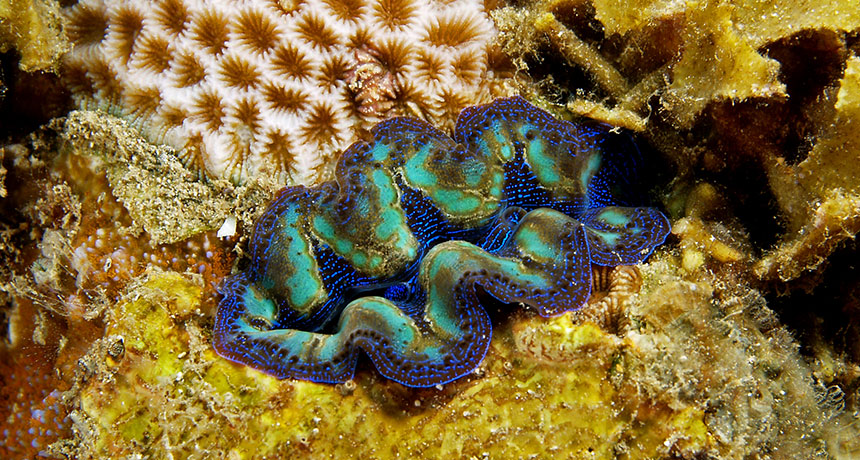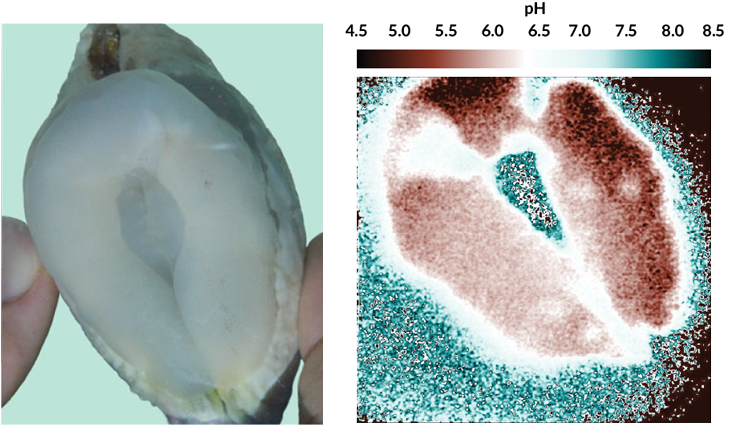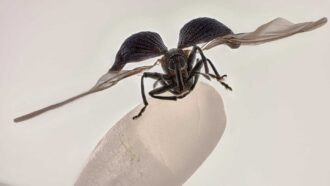Here’s how a clam can hide within a rock
This mollusk’s boring organ is anything but

Showy blue and green frills are the only visible parts of this giant clam. It traps itself for life inside the rocky mass of a reef by a process that’s been misunderstood for decades.
Nhobgood/Wikimedia Commons (CC BY-SA 3.0)
Share this:
- Share via email (Opens in new window) Email
- Click to share on Facebook (Opens in new window) Facebook
- Click to share on X (Opens in new window) X
- Click to share on Pinterest (Opens in new window) Pinterest
- Click to share on Reddit (Opens in new window) Reddit
- Share to Google Classroom (Opens in new window) Google Classroom
- Click to print (Opens in new window) Print
By Susan Milius
Burrowing giant clams have perfected the ship-in-a-bottle trick. Scientists had convinced themselves they couldn’t explain how the clams carved out a big home within a tiny opening. New research finally shows how the mollusks do it. In the process, that research highlights a flaw in tests that had aimed to answer this question decades ago.
Tridacna crocea (Try-DAK-nuh KROH-see-uh) is the smallest of some 10 or so giant clam species. It grows a shell that eventually reaches roughly the size of a large fist. But you would likely never get a chance to see that shell. Starting as youngsters, the burrowers bore into the stony mass of an Indo-Pacific coral reef. As the clams grow, they trap themselves for life behind a too-skinny exit. There, these clams can thrive for decades.
Only the brightly colored upper edges of the clam’s body can push out of the thin slit in the reef. The frills sticking out teem with algae related to those in corals. Basking in sunlight, the algae pay “rent” by providing a great share of the giant clam’s energy.
The clams “actually have eyes in this tissue,” Richard Hill says of the frills. Hill is an environmental physiologist at Michigan State University in East Lansing. At the slightest shadow — a predator, perhaps — the clam yanks in its vulnerable parts through the very narrow crack. “It’s as if the clam vanished,” he says.
The colors the clam creates on its extendable frills approach the psychedelic. And they can bewitch aquarium hobbyists into paying hundreds of dollars to own one. “The ones that get the big money are turquoise,” Hill says. He’s also seen some that are a deep indigo blue, yellow, crimson — even a boring brown.
The opposite rim of the clam body is hidden deep within the coral crevice. It looks anything but colorful. Through a hole near the shell’s hinge, a soft cream-colored mass called (quite unfairly) the “boring organ” can slide out. Like pulling on a gym sock, this tissue spreads upward over the shell. A sock embrace puts the tissue in touch with the cave wall that the clam must erode away, giving it room to grow.
Sir Charles Maurice Yonge was a leading 20th-century mollusk biologist. He had proposed that boring organs might gradually dissolve the rock by secreting acid. Later, he shot down his own hypothesis (and fretted about it throughout the rest of his life). He had tested the idea by adding a color-changing pH indicator to the clam’s seawater. This showed no sign of a surge in acidity.
Hill decided to revisit the mystery. After some epic bouts of Googling options for testing the pH in a liquid, he wondered if what the clam directly contacted was what mattered. To investigate, he found a flat device that could measure pH at lots of points on a piece of foil. He and his colleagues then placed clams beside the device — and hoped the boring organs would push out against this device.
The project required a trip to Japan. It also needed world-class mollusk management to coax clams to reach out their organs and touch the foil in the desired way. When they did, red blotches emerged. They looked like lipstick smudges on a napkin, and pointed to spots of acidity.
The clams may not be able to bring down the pH of a lot of alkaline seawater. They can, however, acidify a surface. That acid can dissolve rock to carve out a hidden cave. Hill and his colleagues shared their discovery June 13 in Biology Letters. Turns out that this organ is boring in the very best sense of the word.








